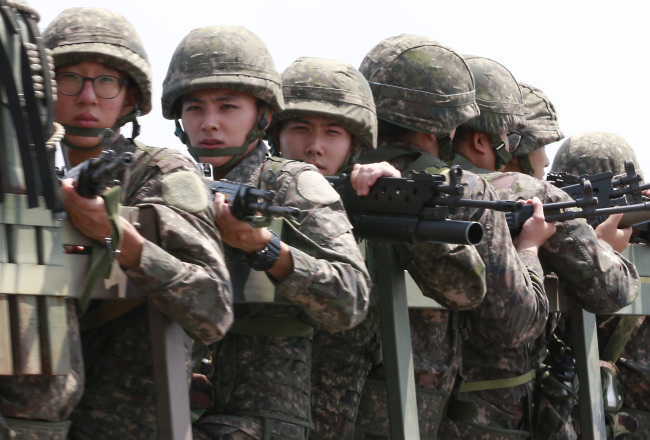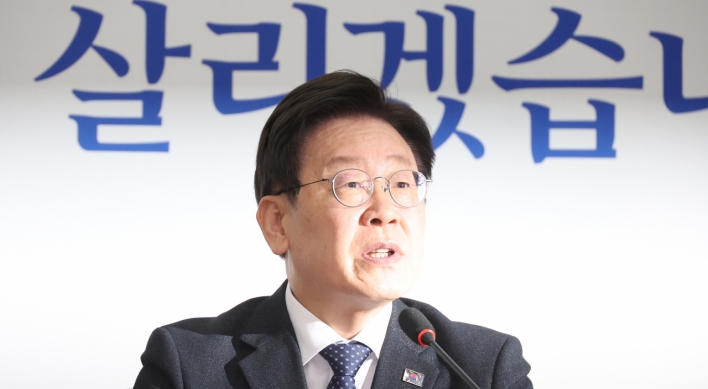N.K. beefs up frontline forces
South Korea, U.S. boost anti-submarine activities, raise Watchcon
By KH디지털2Published : Aug. 23, 2015 - 16:48
The Koreas’ cross-border standoff showed more signs of flaring up on Sunday as the North Korean military sharply beefed up its frontline artillery forces and forward-deployed a majority of its submarines and other offensive assets despite the high-level talks over the weekend.
With negotiations between top Seoul and Pyongyang officials stretching into the second day, the number of North Korean gunners spotted in ready position nearly doubled from Friday, according to military authorities here.
The South’s military was also unable to locate about 50 undersea vehicles, or 70 percent of the North’s submarine fleet, which have left their bases.
“This is an extremely grave situation,” a senior official at Seoul’s Defense Ministry told reporters, requesting anonymity citing intelligence.
“The figure points to the artillerymen who can immediately open fire once they receive an order, not those staying under the tunnels or in their battalions.”
With negotiations between top Seoul and Pyongyang officials stretching into the second day, the number of North Korean gunners spotted in ready position nearly doubled from Friday, according to military authorities here.
The South’s military was also unable to locate about 50 undersea vehicles, or 70 percent of the North’s submarine fleet, which have left their bases.
“This is an extremely grave situation,” a senior official at Seoul’s Defense Ministry told reporters, requesting anonymity citing intelligence.
“The figure points to the artillerymen who can immediately open fire once they receive an order, not those staying under the tunnels or in their battalions.”

In particular, the movement of North Korean submarines is a critical indicator of provocation that Seoul closely keep tabs on at all times, he noted.
The move appears to be designed to seize the upper hand in the protracted negotiations at the border village of Panmunjeom while facilitating an additional provocation in case the talks break down.
“It’s around 10 times the usual. We have not seen in decades that many submarines that are simultaneously out of their bases,” the official said.
“This is the level where we can expect something really worrying to happen ― we don’t know what kind of operations they are and will be undertaking where.”
The discovery came two days after North Korean leader Kim Jong-un placed frontline troops in full combat readiness, declaring a “quasi-state of war.” The regime has since forward-stationed 76.2-milimeter artillery guns near the border and fully armed more soldiers, Seoul officials said
The heavily militarized country is believed to run more than 70 submersibles including 20 1,800-ton Romeo-class, 40 300-ton Sangeo-class and 10 130-ton Yeoneo-class vessels. Albeit old and equipped with outdated weapons, they outnumber the South’s fleet.
In May, it tested a submarine-launched ballistic missile from a newly built 2,000-ton ship. The 2010 torpedo attack on the South corvette Cheonan was made from a Yeoneo-class submarine.
To head off any unanticipated provocation, the South Korean military is maintaining full readiness and mobilizing more antisubmarine assets such as destroyers, P-3C patrol planes and Lynx antisubmarine helicopters, the official added.
The South Korean Navy operates a 13-submarine fleet, consisting of nine units of 1,200-ton 209-class and four of 1,800-ton 214-class. It is pushing to add five 214-class submarines by 2019 and nine 3,000-ton submarines carrying vertical launchers for submarine-to-ground missiles. It launched a submarine force command last February to better counter North Korean threats and carry out underwater operations, training and education, and maintenance.
Meanwhile, the loudspeaker broadcasts continued at all 11 spots as scheduled, which had prompted the North to open fire across the Demilitarized Zone and then the South to shoot back on Thursday.
South Korea and the U.S. late Friday raised their five-stage Watch Condition by one notch to level 2, which will allow them to boost stealth and reconnaissance activities with their RC-135 “snooper” aircraft, Aegis destroyers with radar surveillance systems and spy satellites. During a phone conversation on Saturday, the chairmen of the two countries’ Joint Chiefs of Staff reaffirmed stern punishment against another provocation and agreed to explore ways to deter it.
In a display of force, the allies on Saturday flew eight fighter jets ― four South Korean F-15K and four U.S. F-16. They have also been staging two separate joint military exercises since last week, drawing Pyongyang’s protests.
Monitoring the development of the inter-Korean dialogue, many evacuated residents of five northernmost islands in the West Sea and border towns in Gyeonggi and Gangwon provinces expressed hopes for an early breakthrough. More than 20,000 were initially instructed to take refuge, but some regions in Yanggu and Inje were released from the order, and other people opted to go home as the talks dragged out.
Fishing work around the islands in the West Sea was banned for the third straight day, though all passenger boats departing from Incheon remained in service.
Prime Minister Hwang Kyo-ahn visited a shelter in Paju, Gyeonggi Province, Sunday, requesting cooperation from the residents and examining the overall evacuation facilities and relief items given to the people.
By Shin Hyon-hee (heeshin@heraldcorp.com)







![[Hello India] Hyundai Motor vows to boost 'clean mobility' in India](http://res.heraldm.com/phpwas/restmb_idxmake.php?idx=644&simg=/content/image/2024/04/25/20240425050672_0.jpg&u=)









